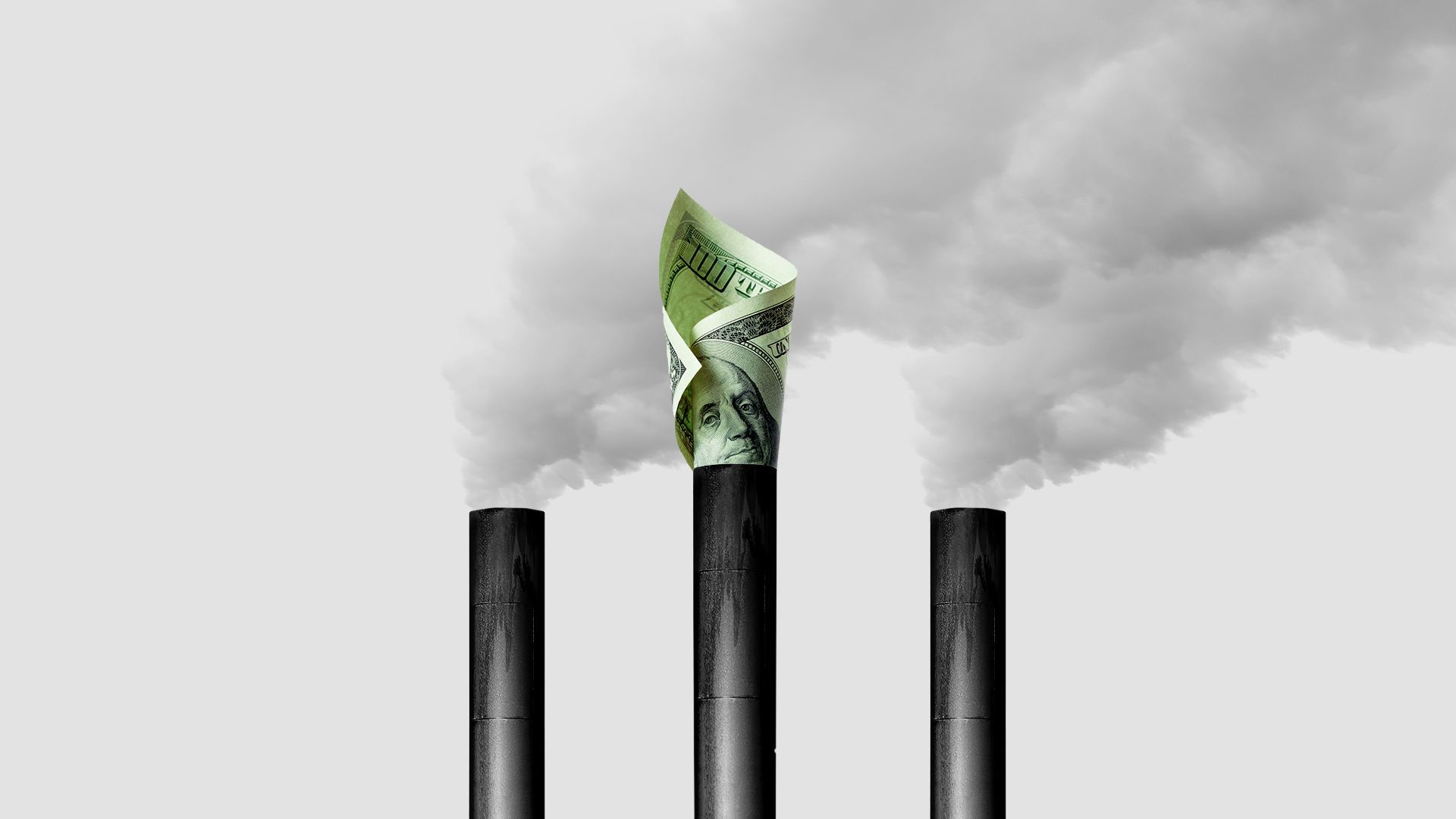| | | | | | | | | | | Axios Generate | | By Ben Geman and Andrew Freedman · Aug 15, 2022 | | 🥞 Welcome back! Today's newsletter, edited by Mickey Meece, has a Smart Brevity count of 1,265 words, 5 minutes. 🚨 The Bill Gates-founded TerraPower raised at least $750 million in its push to develop small-scale nuclear reactors, Bloomberg reports. 🎶 This week marks 35 years since Tom Waits released the album "Franks Wild Years," which provides today's intro tune... | | | | | | 1 big thing: America's new "Extreme Heat Belt" |  Note: Shaded counties are those that will, on average, have 0.5 days or more at or above a 125F° heat index in 2053; Data: First Street Foundation; Map: Axios Visuals A new study reveals the emergence of an "extreme heat belt" from Texas to Illinois, where the heat index could reach 125°F at least one day a year by 2053, Andrew writes. Why it matters: In just 30 years, climate change will cause the Lower 48 states to be a far hotter and more precarious place to be during summer. Driving the news: The findings come from a hyperlocal analysis of current and future extreme heat events published today by the nonprofit First Street Foundation. - The report is unique for examining current and future heat risks down to the property level across the country and joins First Street's other climate risk analyses.
The big picture: As average temperatures increase due to human-driven greenhouse gas emissions, mainly from the burning of fossil fuels, instances of extreme heat are forecast to escalate. - This report comes to the grave conclusion that there will be a twentyfold increase in the number of counties seeing at least one day with a heat index, incorporating air temperature with relative humidity, of greater than 125°F.
Threat level: The analysis, based on First Street's peer-reviewed heat model, shows that the number of Americans currently exposed to "extreme heat," defined as having a maximum heat index of greater than 125°F, is just 8 million. - That is set to grow to 107 million in the next three decades, an increase of 13 times over 30 years.
- The developing "Extreme Heat Belt," as First Street calls it, forms a sweltering region of vulnerability that includes St. Louis, Kansas City, Memphis, Tulsa and Chicago.
- By 2030, some coastal areas in the Southeast and Mid-Atlantic may also experience days with a heat index above 125°F.
Zoom in: The report shows a country that will have to grapple with the effects of increased heat exposure nearly everywhere, though there will be regional distinctions. - The Gulf Coast and Southeast will see the highest probability and longest duration of exposure to "dangerous days," with a heat index greater than 100°F.
Between the lines: The report shows how the characteristics of heat waves may change in the near future. Many spots currently see more than 20 straight days with a heat index above 100°F. By 2053, these streaks could stretch to 74 consecutive days. - The study also sheds light on cooling demand driven by hotter conditions, including cooling-driven increases in carbon emissions.
- Texas, Florida, California, Ohio and Missouri comprise the top 5 states with the biggest cooling demand-related uptick in CO2 emissions between now and 2053.
Read the whole story. |     | | | | | | Bonus: "Dangerous days" proliferate in the South |  Data: First Street Foundation; Map: Erin Davis/Axios Visuals Florida is ground zero for seeing an increase in dangerous days, which feature a heat index of greater than 100°F, per First Street, Andrew writes. Threat level: These are led by the highly populated areas of Miami-Dade, Broward and Palm Beach counties. What's next: Communities are innovating to reduce the impacts of extreme heat, as Axios' Jennifer A. Kingson recently reported. |     | | | | | | 2. Charted: The limits of the electric car credits |  Data: Resources for the Future; Chart: Axios Visuals A new analysis starkly lays out the limits of U.S. electric vehicle tax incentives in the Democrats' soon-to-be-enacted climate bill, Ben writes. Catch up fast: The bill, which passed the House Friday and President Biden is slated to sign soon, expands purchase subsidies. But it also ties them to strict rules on battery materials sourcing, vehicle costs, and buyers' income. What's new: Beia Spiller of Resources for the Future (RFF), a nonpartisan think tank, translated Congressional Budget Office estimates of the incentives into projected real-world sales. Even by 2030, vehicles purchased using the credits would be just 3% of total EV sales last year. Threat level: "[G]iven the country's goals for achieving 50 percent zero emission vehicles by 2030, the tax credit will not go far enough," writes Spiller, who leads RFF's transportation program. - "Until auto manufacturers in the private sector make significant changes to their manufacturing processes and resulting vehicle price points, you — and most other car buyers in the market for EVs — may need to forego the tax credit if you want to go electric."
🚨ICYMI: Please check out Andrew's story Friday that focused on what the legislation means for energy consumers — and when. One big part... - For the country's 122 million households, it contains about $100 billion for electrification programs at the neighborhood level, according to Rewiring America, a nonprofit group that helped shape some provisions.
- These are designed to tilt the playing field toward the most energy-efficient option when you need to make a big purchase, such as for a new water heater or air conditioner, by making electric appliances cheaper.
|     | | | | | | A message from Chevron | | It's only human to help power a brighter future | | |  | | | | At Chevron, we believe the future of transportation is lower carbon, and hydrogen fuel can help us get there. We're partnering with vehicle makers and commercial truck fleet operators to scale the hydrogen fuel industry, because we believe innovation can help power a brighter future. | | | | | | 3. How cleantech subsidies could boost EPA rules |  | | | Illustration: Rebecca Zisser/Axios | | | | One more thing about the bill! There's connective tissue between the clean energy incentives and future regulations, Harvard Law's Jody Freeman argues in the New York Times, Ben writes. Why it matters: Subsidies and regulations are separate tools, but the former Obama White House aide says the expanded investments give EPA more running room. How it works: When EPA sets emissions standards for power plants, it's required to consider technology availability and costs, Freeman notes, which means... - "By bringing down the cost of carbon capture technology, which captures emissions at the smokestack so that those gases can be buried or repurposed, Congress has made it more likely that companies will use it, and more likely that the E.P.A. can require it."
- The bill's financial support for cleaner cars and trucks could also bolster the case for tougher vehicle emissions standards, she writes.
|     | | | | | | 4. 🏃🏽♀️Catch up fast: Aramco and nuclear power | | 🛢️Saudi Aramco, the kingdom's state oil giant, saw profits soar to $48.4 billion (not a typo) in the second quarter, a 90% (!) year-over-year boost, Ben writes. - The big picture: High prices provided a huge haul for the world's largest oil company, which is boosting capital investment. CEO Amin Nasser told analysts Sunday that Aramco plans to boost production capacity to 12.3 million barrels per day by 2025, S&P Global reports.
- What they're saying: "We expect oil demand to continue to grow for the rest of the decade, despite downward economic pressures on short-term global forecasts," Nasser said in a separate statement.
- The intrigue: Aramco's long-term strategy rests on the promotion of the relatively low carbon intensity of its crude. It plans to be the last man standing even in a carbon-constrained world.
⚛️ California Gov. Gavin Newsom is proposing legislation to extend the life of Diablo Canyon, the state's sole operating nuclear plant, for 5-10 years, several outlets reported. - Why it matters: The plant is slated to close in 2025, but California regulators are struggling to meet climate goals while ensuring enough power.
🚰 A Tuesday deadline looms for Colorado River states to submit a plan to cut water use as climate change and overuse shrink supplies. |     | | | | | | 5. Meet the UN's next climate boss (we think) |  | | | Photo Illustration: Shoshana Gordon/Axios. Photo: Ben Stansall/AFP via Getty Images | | | | The United Nations plans to tap Simon Stiell, Grenada's former climate resilience minister, as its next climate chief, per reports in Climate Home News and Reuters, Ben writes. The big picture: Stiell could augment the views of small island nations, which face existential threats from rising seas and more intense storms. He would replace Patricia Espinosa, who took over after the 2015 summit that produced the Paris Agreement. Why it matters: Stiell faces the fraught task of pushing countries to go beyond mere nonbinding pledges and impose tougher real-world emissions-cutting and aid policies. A key topic at the next UN climate talks late this year is "loss and damage" — the term for compensating poor nations for harms they've played little role in causing. Catch up fast: Climate Home News points out Stiell has chaired the "High Ambition Coalition" — which unites small island states but also Norway and some other wealthy nations — that seeks aggressive measures in global negotiations. |     | | | | | | A message from Chevron | | It's only human to help power a brighter future | | |  | | | | At Chevron, we believe the future of transportation is lower carbon, and hydrogen fuel can help us get there. We're partnering with vehicle makers and commercial truck fleet operators to scale the hydrogen fuel industry, because we believe innovation can help power a brighter future. | | | | 📬 Did a friend send you this newsletter? Welcome, please sign up. Thanks for reading and have a great day! We'll see you back here tomorrow. |  | | Why stop here? Let's go Pro. | | | | | | Axios thanks our partners for supporting our newsletters. If you're interested in advertising, learn more here.
Sponsorship has no influence on editorial content. Axios, 3100 Clarendon Blvd, Arlington VA 22201 | | | You received this email because you signed up for newsletters from Axios.
Change your preferences or unsubscribe here. | | | Was this email forwarded to you?
Sign up now to get Axios in your inbox. | | | | Follow Axios on social media:    | | | | | |









No comments:
Post a Comment